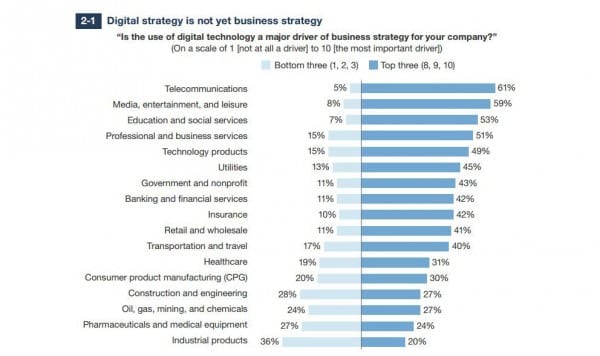Alignment vs Impact: Why businesses must get a grip of digital
Managers of digital transformation initiatives should ask where does digital strategies ‘sit’ compared with more general business and marketing strategies - where does leadership of the digital agenda actual come from, and is that right? A new report from Forrester, State of Digital Business 2014 , has revealed major disconnects between the marketing and technology sides of businesses. The survey responses from 1,591 senior business leaders in the UK and US during November 2013 to January 2014, signals a “digital strategy execution crisis."
In the report, 74% of executives report that their company has a digital strategy - yet a ‘digital strategy’ often means something different in each business.
What does digital strategy mean to you? It’s often a quick tactical respond - moving spend into digital display ads, re-targeting and email within a CRM programme, search engine marketing. Or is it bigger than that, involving a programme of digital transformation, creating a roadmap to increase the contribution to the business from digital technologies and media in a structured way.

More insight from the Forrester report:
- Just 21% of CEOs set a clear vision for digital (in firms over 250 employees), this drops to 17% in firms with 1,000–10,000 employees
- Education and social services will be the “next big industry” to go digital and 83% of executives in this sector expect the “digital threat” to disrupt their organisation in 2014. Threat? A telling terminology perhaps? How about huge opportunity?
Impact vs Alignment
We refer to this key consideration in digital strategy in our latest guide, Digital Transformation as a case of seeking strategic impact vs strategic alignment for digital marketing. So, should digital strategy align with or impact broader business and marketing strategies? The ideal answer is of course ‘both’. But if businesses haven’t been through a transformation programme the true answer may be neither.

Recommended Guide: Managing Digital Transformation
Create a roadmap to increase the contribution of digital media and technology for your business.
Download our Managing Digital Transformation Guide.
Whereas companies like Burberry and Coca-Cola score highly for defining a vision demonstrating that its digital strategy is central to its business transformation, yet others regard digital strategy only in terms of moving paid advertising to digital display, creating a new mobile app or developing a social media presence – approaches which the Forrester labels as ‘bolt-on’ and we call alignment.
Digital alignment
Business and marketing strategy should inform digital strategy - a natural hierarchy of business planning. However, alignment implies efficiency in managing and executing digital marketing activities, but they are not necessarily the right digital marketing activities... We’d suggest that seeking alignment is about doing what must be done in 2014, demonstrating how digital marketing investments are supporting current marketing or strategic business initiatives. For example, referencing the 5S Marketing goals would help alignment in a digital plan and inform exactly how digital marketing can support different business initiatives in these key areas:
- Sell – Specific business initiatives to grow sales by targeting new markets or new product development
- Speak – customer communications initiatives
- Serve – customer service improvement
- Save – Cost reduction through use of digital media to reduce print costs
- Sizzle – Supporting brand initiatives
Creating digital impact?
Impact means that digital strategies drive commercial improvements by reviewing new strategic options such as new business models and new ways of building relationships with customers. Often the sexy stuff that we read and take note of, maybe enviously gaze upon. It’s much harder to create impact for most of us since we’re not often a business stakeholder. An impacting strategy is in place if companies have reviewed whether broader and bigger changes are needed to grow revenue and make the most of digital opportunities. We see this with brands that make fundamental shifts in their marketing, brands such as:
- Coca-Cola and their move towards content marketing and building consumer connections, marketing that serves
- Barclays Bank and their Digital Eagles initiative to help communities learn the critical web and computer skills
- Lloyds Pharmacy creating a portal to answer customers medical questions
- American Express creating the Open Forum to enable customers to share start-up and SME business growth knowledge
- Even O2’s ‘Be More Dog’ campaign illustrates very significant levels of integration, driving their audience to do something
The Forrester report concludes with some compelling, if not fairly obvious, advice:
- An alignment or ‘bolt-on’ approach to digital will not suffice for most businesses from 2015. Businesses will need to take a more comprehensive approach to digital transformation where the business, not marketing, is the principal driver behind digital strategy.
- Leadership, and the communication between CMOs and CIOs are the factors in transforming towards a digital business. Combining operational effectiveness with customer experience.
- CIOs need to look beyond operations and support the business’ ability to win, serve and retain customers.
But what about marketers, what role can you play in this? Our sense at Smart Insights is that marketing also has to see digital as a channel through which to serve customers, and potential customers, creating experiences over and above simply treating digital as a new interactive advertising communications channel.









